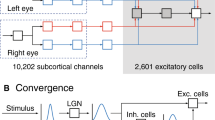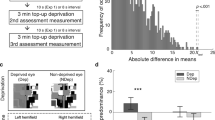Abstract
IN the visual system of young kittens, the layout of the cortical maps for ocular dominance and orientation preference converges to an equilibrium state within the first few weeks of life and normally remains largely unchanged. If during the critical period, however, patterned visual experience is restricted to only one eye for a few days, cortical neurons lose their ability to respond to stimulation of the deprived eye. We used the 'reverse occlusion' protocol together with chronical optical imaging to investigate how the profound anatomical changes accompanying monocular deprivation1 affect the spatial pattern of the cortical orientation preference map. We report here that after 1 week of monocular deprivation, cortical orientation maps for the deprived eye had vanished. But we also discovered that after subsequent reverse occlusion the restored orientation maps were very similar to the original maps. This demonstrates that in spite of functional disconnection of one eye after monocular deprivation, the layout of cortical orientation maps, when re-established for this eye, is not formed from scratch but is strongly influenced by previous experience.
This is a preview of subscription content, access via your institution
Access options
Subscribe to this journal
Receive 51 print issues and online access
$199.00 per year
only $3.90 per issue
Buy this article
- Purchase on Springer Link
- Instant access to full article PDF
Prices may be subject to local taxes which are calculated during checkout
Similar content being viewed by others
References
Antonini, A. & Stryker, M. P. Science 260, 1819–1821 (1993).
Hubel, D. H. & Wiesel, T. N. J. Physiol. 206, 419–436 (1970).
Blakemore, C. & Van Sluyters, R. C. J. Physiol. 237, 195–216 (1974).
Movshon, J. A. J. Physiol. 261, 125–174 (1976).
Van Sluyters, R. C. J. Physiol. 284, 1–17 (1978).
Grinvald, A., Lieke, E. E., Frostig, R. D., Gilbert, C. D. & Wiesel, T. N. Nature 324, 361–364 (1986).
Frostig, R. D., Lieke, E. E., Ts'o, D. Y. & Grinvald, A. Proc. natn. Acad. Sci. U.S.A. 87, 6082–6086 (1990).
Ts'o, D. Y., Frostig, R. D., Lieke, E. E. & Grinvald, A. Science 249, 417–420 (1990).
Bonhoeffer, T. & Grinvald, A. Nature 353, 429–431 (1991).
Mioche, L. & Singer, W. J. Neurophysiol. 62, 185–197 (1989).
Blakemore, C. & Hawken, M. J. J. Physiol. 327, 463–487 (1982).
Swindale, N. V., Matsubara, J. A. & Cynader, M. S. J. Neurosci. 7, 1414–1427 (1987).
Blasdel, G. G. J. Neurosci. 12, 3139–3161 (1992).
Bonhoeffer, T. & Grinvald, A. J. Neurosci. 13, 4157–4180 (1993).
Kossut, M. & Singer, W. Expl Brain Res. 85, 519–527 (1991).
Hubel, D. H. & Wiesel, T. N. J. Physiol. 160, 106–154 (1962).
Chapman, B., Zahs, K. R. & Stryker, M. P. J. Neurosci. 11, 1347–1358 (1991).
Shatz, C. J. & Stryker, M. P. J. Physiol. 281, 267–283 (1978).
Fitzpatrick, D., Zhang, Y., Schofield, B. R. & Muly, E. C. Soc. Neurosci. Abstr. 19, 179.2 (1993).
Author information
Authors and Affiliations
Rights and permissions
About this article
Cite this article
Kim, DS., Bonhoeffer, T. Reverse occlusion leads to a precise restoration of orientation preference maps in visual cortex. Nature 370, 370–372 (1994). https://doi.org/10.1038/370370a0
Received:
Accepted:
Issue Date:
DOI: https://doi.org/10.1038/370370a0
This article is cited by
-
Perceptual judgements and chronic imaging of altered odour maps indicate comprehensive stimulus template matching in olfaction
Nature Communications (2013)
-
Life imitates op art
Nature Neuroscience (2011)
-
VSDI: a new era in functional imaging of cortical dynamics
Nature Reviews Neuroscience (2004)
-
Development and plasticity of cortical areas and networks
Nature Reviews Neuroscience (2001)
-
High-resolution mapping of iso-orientation columns by fMRI
Nature Neuroscience (2000)
Comments
By submitting a comment you agree to abide by our Terms and Community Guidelines. If you find something abusive or that does not comply with our terms or guidelines please flag it as inappropriate.



